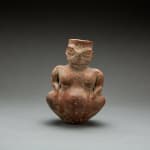Neolithic Çatalhüyük Terracotta Fertility Goddess, 6000 BCE - 5000 BCE
Terracotta
17.1 x 10.2 x 10.2 cm
6 3/4 x 4 x 4 in
6 3/4 x 4 x 4 in
LO.554
Further images
In 1958, British archaeologist James Mellaart discovered the Neolithic settlement known as Çatalhüyük in Southern Turkey near the city of Konya. Dated from around 7500 to 5700 B.C., the ruins...
In 1958, British archaeologist James Mellaart discovered the Neolithic settlement known as Çatalhüyük in Southern Turkey near the city of Konya. Dated from around 7500 to 5700 B.C., the ruins of Çatalhüyük constitute the largest and best preserved Neolithic site yet found. Much has been learned about the settlement from subsequent excavations. Çatalhüyük appears to have been devoted entirely to domestic buildings, with little evidence for any public architecture. Unlike modern cities, there were no streets. Instead, the roofs of the mud-brick houses served both as the thoroughfares. Doors were on the ceiling with stairs or ladders leading into the living spaces. Over time, crumbling houses were destroyed and rebuilt, leading to multiple layers of settlement. While little is known about their religious beliefs, the people of Çatalhüyü buried their dead within the village. Some remains bear evidence of ritual decoration, similar to other Neolithic sites in Syria and Jericho. Murals and figurines have been uncovered throughout the settlement, and interiors and exteriors of buildings were adorned with head of animals, especially cattle, mounted on the wall, all suggesting that the ancient society had a distinctive religious belief system rich in symbolism.







